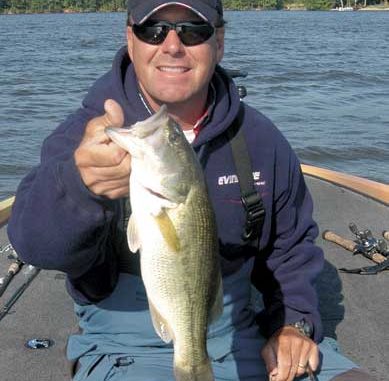
September is almost a tougher month to fish than August, because bass are in transition, moving into creeks as baitfish make their fall migration.
You can’t key on normal bottom structure or cover because bass spend so much time suspended under and around schools of baitfish. You can’t always count on bumping a crankbait down a rocky bank or flipping a worm or jig under a dock to produce fish.
But one thing that you can count on being fairly consistent in September is the topwater bite. It’s the thing that keeps bass fishermen from spending too much time in dove fields or tree stands this month, because it can be a good way to catch bass when the fishing is otherwise tough.
Typically, what we have in September across South Caro-lina is a lot of shad starting to move into the feeder creeks. That makes it tough to fish because you’ve got to know where most of the shad are to even have a chance to catch any bass. You have to be able to track their movements, because they can really cover some water. You’re sort of fishing by the seat of your pants.
If you find bass one day, you’d better catch ’em and enjoy it, because they may not be there the next day, and you may not find that group of fish again the whole fall.
One thing I’ve found to be true about the way bass shadow the movements of baitfish is that they’re suspended, and you can get more reaction bites on topwater plugs than you can on spinnerbaits and crankbaits. The other is that over the course of a day on the water, you will normally run into some schooling fish that you can catch. And 15 minutes with a nice school of bass busting shad is enough to make anybody’s day.
I like to fishing popping-type baits like a Pop-R or Yellow Magic. I also like to fish big stickbaits like a Zara Spook, especially if I’m around schooling fish. What I will typically do is start on the main lake, just outside the mouth of a creek, because the shad and bass may just be starting to move in.
I’ll fish around main-lake points, always keeping my eye out for schooling activity, but knowing that you can call bass up with a topwater in the fall.
I’ll blind-cast around those places until I really get a better grip on where most of the shad are and whether or not the bass are right on them. As the month progresses, I’ll naturally work back into the creeks as the shad move farther and farther back. We’ll normally have some cooler weather toward the end of the month, and that will change things.
I like to use fairly light line and a medium-action rod for fishing topwater baits, especially on schooling fish. I’ll use a 7-foot All-Star casting rod and Pfleuger Presidential reel spooled with 10-pound Berkley Sensation.
You need to make really long casts to schooling fish, and the lighter line helps because you can cast it so much farther. That’s something you really need when, say, a school of bass herds some shad to the surface, and you’re 40 yards away. You need to be able to get a bait to those fish without having to take 10 or 15 seconds to get within normal casting range.
And there’s no real danger in getting broken off, because most of the fish you’re casting to are out in open water; you don’t have to worry about one getting wrapped up around a pier piling or in the limbs of a laydown tree.
One thing that will really help you catch more fish on topwater is a follow-up bait. Bass are notorious, especially when they are real excited and schooling on shad at the surface, for slapping or hitting at a lure and missing — knocking it up in the air or whatever. And even the best fishermen will sometimes jerk a topwater bait away from a fish by not waiting to feel the fish after a vicious strike.
Having a rod or two rigged with follow-up baits will allow you to get a bait back into the area where you’ve missed a strike, and get it down below the surface, where a lot of bass are lurking, looking for shad that have been crippled and are struggling, sinking and dying.
I like to use two different baits for follow-ups. I like to fish a Berkley Jerk Shad — which is a soft-plastic jerkbait — in a shad color or some kind of white color. I’ll rig it on an Owner hook that’s heavy enough to sink the bait a few inches without having to add weight, which tends to impede the bait’s natural action.
If I miss a strike, I’ll throw it out there and let it sink, so it acts like it’s a dying baitfish. The other bait I like to use is a Berkley Saltwater Mullet. That’s a 5-inch-long swim bait that comes rigged with one hook. If you miss a strike, you can cast in the same area, let it sink down a little and swim it back through the schooling fish, several feet beneath the surface. That can be a deadly way to follow up on a missed topwater bite.
Of course, not missing that first bite is always more fun.
Davy Hite is a 42-year-old native of Saluda who lives in Ninety Six, S.C. He has fished professionally since 1993. He was the BASS Angler of the Year in 1997 and 2002, and he was won the 1999 Bassmasters Classic and the 1998 FLW Tour Championship. He is sponsored by Triton boats, Evinrude outboards, All-Star rods, Pfleuger reels, Pure Fishing (Berkley), Owner hooks and Solar Bat sunglasses.




Be the first to comment